Introduction
As practitioners dedicated to enhancing children's communication abilities, understanding the nuances of auditory challenges is crucial. A recent study, "On the Etiology of Listening Difficulties in Noise Despite Clinically Normal Audiograms," provides invaluable insights into hidden hearing issues that may not be apparent in standard audiograms. This blog explores how practitioners can leverage these findings to improve diagnostic and therapeutic outcomes for children.
Understanding Hidden Hearing Loss
The study highlights that many individuals, particularly children, experience listening difficulties in noisy environments despite having clinically normal audiograms. This phenomenon, often referred to as Hidden Hearing Loss (HHL), can result from deficits at the auditory periphery or central auditory processing issues. These deficits can significantly impact speech intelligibility in noise, a common challenge in educational settings.
Key Findings and Implications
- Extending audiograms beyond 8 kHz can reveal early signs of noise-induced trauma, potentially identifying "hidden" losses at lower frequencies.
- Impaired central auditory processing, possibly due to developmental disruptions, can lead to listening difficulties, necessitating differentiation from cognitive or linguistic deficits.
- Improved diagnosis of these underlying causes can lead to better-targeted auditory training procedures, optimizing treatment outcomes for individual patients.
Practical Applications for Practitioners
Practitioners can enhance their diagnostic acumen by incorporating advanced psychoacoustic and electrophysiologic approaches highlighted in the study. Here are some actionable steps:
- Extended Audiograms: Consider extending audiometric testing to include frequencies above 8 kHz to detect early signs of cochlear damage.
- Comprehensive Auditory Assessments: Use a combination of psychoacoustic tests and electrophysiological measures to distinguish between peripheral and central auditory deficits.
- Customized Auditory Training: Tailor auditory training programs to address specific deficits identified through comprehensive assessments, improving speech intelligibility in noise.
Encouraging Further Research
The study underscores the need for continued research into the etiology of listening difficulties. Practitioners are encouraged to stay abreast of emerging diagnostic tools and therapeutic strategies. Collaborating with researchers can provide valuable insights and contribute to the development of innovative solutions for children facing auditory challenges.
Conclusion
By embracing data-driven approaches and leveraging the latest research findings, practitioners can significantly enhance the outcomes for children with listening difficulties. Understanding and addressing hidden hearing loss is a critical step in ensuring that all children have the opportunity to thrive in their communication and educational endeavors.
To read the original research paper, please follow this link: On the Etiology of Listening Difficulties in Noise Despite Clinically Normal Audiograms.










